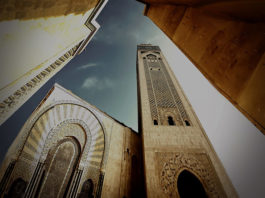Detailed account of Muslims in China:
The Ancient Record of the Tang Dynasty notes that in the second year of
the rule of Gaozong (31; A.D. 651) an emissary from Arabia came to the
royal court bearing gifts. The emissary claimed that his state had been established thirty-one years before, which would mean that he reached the Tang court during the Caliphate of Uthman. According to the traditions of the Muslims of China this is considered to be the first time that Islâm was brought to China. The leader of this delegation was Said Ibn Abi Waqqas, one of the noted Companions of the Prophet. His party included fifteen persons who had travelled together by way of the Indian Ocean and the China Sea to the port city of Guangzhou in southeaster China, going overland from there to the capital city, Chang’an, where they paid their respects to the emperor.
The emperor, after searching inquiries about Islâm, gave general approval to the new religion — which he considered to be compatible with the teachings of Confucius — but he felt that five daily prayers and a month of fasting were requirements too severe for his taste, and he was not converted. He gave Said Ibn Abi Waqqas and his delegation freedom to propagate their faith and expressed his admiration for Islâm by ordering the establishment of the first mosque at Chang’an, an important event in the history of Islâm. This mosque still stands in excellent condition in modern Xi’an after ages of repairs and restorations.
Years later when Said Ibn Abi Waqqas was advanced in age and in ill health, he received permission to return to his homeland, but unfortunately he died on the way and was buried at Guangzhou. The mosque built near the site of his grave, is still preserved today, the second historic mosque in China. Most of his followers died in China and others returned to their homeland.
The first Muslims to arrive in China came by the sea route, following the example of the visit and preaching of Said Ibn Abi Waqqas and his party which laid the foundation stone of Islâm in China. Many Arab and Persian visitors came to China for commercial and religious reasons, both under the Umayyads and the Abbasids. The Arabians who came in the time of the Umayyads were known in China as the White Robed Tashi and when relations between China and the Muslim empire further improved under the Abbasids, their emissaries were known as the Black Robed Tashi.
The Umayyads and Abbasids sent five or six delegations to China, ranging from
a few to a score of persons in each party, bringing precious gifts to the Chinese emperors. These delegations were cordially received by the Chinese and laden with gifts to carry back to the Caliphs, indicating the continuing friendly relations between China and the Muslim rulers.
In the century and a half between 31 and 184 (A.D. 651-800) a considerable number of Arabs and Persians came to China by the sea route. Initially they settled in Guangzhou but gradually began to push their way along the coast to the main cities and even as far north as Hangzhou. Wherever they went they gathered contributions and built mosques as centres for their religion, mosques which were relatively large and well-built, attesting to the substantial economic position of the traders. Many of
those historically important mosques are still preserved, but in some places the converts have dwindled through the ages and the mosques remain today as historical ruins. During this period a growing number of Arabs and Persians settled down in China, many of them marrying Chinese.
The Arabs and the Persians who came to China by sea exercised great influence in trade with a virtual monopoly of the import and export business. By the time of the Song dynasty (349-678; A.D. 960-1279) a foreign quarter and bazaar had been established in Guangzhou. The office of Director General of Shipping was created to take charge of the movement of commodities through the port and to supervise customs and other commercial matters — a post which was for the most part held by a Muslim.
While the Muslims who came by sea were settling in the south along the coast, Islâm was introduced into northwest China by the overland route. For some time the Xiongnu tribes of northwest China had caused constant border disturbances. After they were conquered by the Arabs these tribes were gradually converted to Islâm. During the Tang dynasty, in 138-146 (A.D. 755-763), Emperor Xuanzong was faced with the An Lushan rebellion which forced him to take refuge in Sichuan. He sent emissaries to ask for assistance from the Abbasid Caliph of Baghdad who sent him a
deputation of 40,000 soldiers who aided him in his struggle with the rebels. In recognition of their valuable services Xuanzong gave the soldiers the choice of returning to their homes laden with gifts or of remaining in China. When they all elected to remain they were settled on farm land and given young women in marriage. Thus they were provided with land, homes, and an opportunity to live in peace and happiness. These new settlers became the part of the founding fathers of the Muslim communities of northwest China.
The improved relations with the Xiongnu tribes brought greater numbers
of their people into China proper for business, many of whom chose to settle there. Still later Iranians, Central Asian Turks and Afghans came through the northwest to Chang’an, continuing the introduction of Islâm to China by the overland route.
The Rise and temporary Fall of Islâm in China
During the Tang dynasty (ended 295; A.D. 907) and the Song dynasty (349-678; A.D. 960-1279) foreign trade grew steadily as Arabs, Turks and Iranians took silk, art objects, Chinese porcelain, and other commodities to the Middle East and to Europe, returning with herbs, spices, pearls, and other products of those areas. They became middlemen in a most profitable trade which attracted ever greater numbers for commerce and the propagation of their faith, and as the new traders came to China more Muslim communities were established in the southeast and northwest parts of the country.
These Muslim communities became a strong force in Chinese society. Because these Arab, Turk and Iranian Muslim were law-abiding and self-disciplined citizens of high economic status they were received with respect and friendship by the Han (Chinese) people and were given the confidence and protection of the government. During the Tang and Song dynasties there was no anti-foreign feeling on the part of the government, and the Muslim population was able to increase steadily and move inland. Thus the Chinese and Islâm lived together in harmony and tolerance.
The Yuan dynasty was considered a foreign dynasty because it started under Genghis Khan, whose Mongol forces occupied China, Central Asia, Iran, Arabia, and parts of Eastern Europe. When these areas were divided into various kingdoms, Kublai Khan became the ruler of China and Mongolia, and the founder of the Yuan dynasty. Of the other areas which were for a time under Mongol control, the kingdoms of Central Asia were converted to Islâm. Throughout the whole area the freedom of travel
maintained by the Mongols encouraged great crosscurrents of peoples and
cultures — the Chinese into Central Asia and the Arabs, Turks, and the Iranians into China — which brought an influx into China of Muslim merchants and also Muslim doctors, scholars, astronomers, astrologers, and high-ranking warriors who were attached to the Mongol army as advisors, military aides, and staff officers. Although the Yuan dynasty was Mongolian, Muslims enhanced their standing by holding positions of military and civil power, and the propagation of the faith was greatly facilitated. According to the eminent Chinese historian Professor Ding Xuewu Ting,
over thirty Muslims were high officials at the royal court in Peking, and the governors of nine provinces were Muslims.
Of the many important Muslims at the royal court of the Mongols, Sayid Ajal was the most prominent. Rising through a series of high offices, he became Commander-in-Chief of the Mongolian Expeditionary Forces in Sichuan and was appointed the governor of the province in 671 (A.D. 1272). Two years later he was transferred to the governorship of Yunnan where his enlightened and glorious rule hastened the spread of Chinese culture into the remote southwest, bringing the Thai and Malay indigenous
people of Yunnan, Chinese law, education, and improved agriculture. He did this without prejudice as to race or religion and without forced conversion of the people to Islâm — on the contrary, he was the first to establish Buddhist and Daoist temples in Yunnan. Many of the cultural patterns of the present day are due to this great governor whose name is still revered by all the people of Yunnan, Han and non-Han alike. Were it not for his religion, he would long since have been worshiped!
in the temples.
The great Iranian historian, Rashidu’d-Din Fadlu’llah, in his remarkable history Iami’u’t-Tawarikh — the first volume of which deals with the history of the Mongols — tells us that
| “China during the Mongolian dynasty of Kublai Khan was administered in twelve districts, with a governor and vice-governor in each. Of these twelve governors, eight were Muslims. In the remaining districts, Muslims were vice-governors.” |
Thus we can imagine the status and importance of Muslims in China during the
Yuan dynasty
The Yuan dynasty lasted for roughly ninety years (678-770; A.D. I 279-1368) until it was overthrown and the Ming dynasty was established. During the Ming dynasty — which ruled almost three centuries, from 770 to 1054 (A.D. 1368-644) — the Muslims made many great contributions to the life of China, and Islâm continued to occupy its rightful place as a popular religion.
By the beginning of the Ming dynasty Islâm had been in China for seven centuries. The considerable number of Muslims who had settled in China and the conversions that ensued among the Chinese had laid a secure foundation for Islâm, but during those seven hundred years in spite of the overall assimilation of foreign settlers into the Han Chinese mainstream, some Arab, Turkic, Iranian and Afghan Muslims had retained their alien status as a special class which preserved its own language, customs, and manners and was not yet fully integrated with the Han people. Under
the Ming dynasty, however, they slowly lost their alien status and became Chinese citizens, and their manner of living was gradually Sinicized.
The most striking example of this process of integration was the adoption of Chinese surnames. Many foreign Muslims who married Chinese wives adopted the name of the wife. In most cases they picked Chinese names which sounded closest to their original names. For example, the surname Ma originally belonged to a prominent Han Chinese family and many historical figures were named Ma. Many Muslim men from the Middle East and Central Asia whose names started with the letter M took the name Ma, partly because of the similarity in sound, and partly because the Muslims
love horses and the character Ma stands for horses. Thus so many Muslims of northwest China bear the surname Ma that there is a common saying,
| “Nine Ma in ten Muslims.” |
The Chinese surnames Mo, Mai, and Mu have been adopted by Muslim immigrants whose names were Mohammed, Mustafa, Murad, Masoud. Many of them who found no existing common Chinese surname sounding like their names simply used the Chinese character sounding closest to their name — Da for Daoud and Tahir; Ha for Hassan; He for Hussein; Ding for Jelaluddin, Shamsuddin, Ghamaruddin; Sai for Said and Sâd; Na for Nasser and Naguib; Sha for Salem, Salih, Sabih; Ai for Issa
and Amin.
The Ming dynasty may be called the golden age of Muslims in China, for long years of peace and prosperity brought a flowering of art and culture in which the Muslims participated. Prominent Muslims had taken part in the establishment of the Ming dynasty, and later, in the reign of Yongle from 808 to 836 (A.D. 1405-32), the eminent Muslim statesman Zheng. He was sent by the monarch to establish friendly relations with the countries of the southeast Asia and with India, Arabia, and East Africa. During the Ming dynasty Muslims continued in positions of power, it is
even said that the Ming was a dynasty of Muslims. There is even evidence for the claim that Zhu Yuanzhang (Hongwu), the founder of the dynasty, is a Muslim.
It is pointed out that his wife, Empress Ma, was a Muslim Turkic princess from Central Asia, that many of his responsible officials are Muslims, that he never worshiped in a temple after his accession, that he forbade public drunkenness, that he composed the hymn of praise of one hundred words to the Prophet Muhammad (p.b.uh.) which may still be found inscribed in the main mosque in Nanjing, and that
historians mention his “strange” facial features, which may have been due to
foreign blood as a descendant of a Persian or Arab. At any rate, Muslims were well treated during the Ming dynasty and there was perfect harmony between the Muslim and the non-Muslim Chinese.
The Qing dynasty ruled from 1054 to 1329 (A.D. 1644-1911). This last imperial dynasty of China was not a dynasty of the Han people, but of another smaller Chinese ethnic group that managed to secede from China, the Manchus. The Manchus established by force the Qing imperialism which ruled over the majority of Han, Turkic, Mongolian, and Tibetan people. Their ruthless policy of divide and rule, setting off one group of people against another, meant the beginning of trouble for the Muslims of China. The Qing dynasty, jealous of the influence of the Muslims and
fearful of a counterrevolutionary attempt to restore the Ming dynasty,
created many incidents to foment anti-Islâmic feeling.
The Chinese Muslims reacted with violence several times and the Qing dynasty retaliated with their army. Since their armies were led and manned by Han soldiers
from southeast China, these incidents have led to enmity between northern and southern Han Chinese that until today continues to present a dangerous threat to Chinese national unity. There were four major so-called Muslim rebellions between 1236 and 1293 (A.D. 1820-76) even though many non-Muslims participated in the revolutionary struggle to free China from the Machu yoke.
The loss of life and property as a consequence of these events was severe, and the spiritual and psychological reactions of the Muslims were unfortunate. However with the downfall of the Manchu dynasty and the establishment of the Republic of China, the status of the Muslims in China entered a new era because the founder of the Republic, Dr. Sun Yat-sen, in his wisdom and foresight, proclaimed that all the components of the Chinese mosaic have equal status in that they are all of a big family.
(NOTE: If you want to build a strong and powerful relationship with Allah, check out Islamia TV, where you can watch Islamic speakers from across the globe deliver inspiring and motivational courses. Learn more at www.islamia.tv.)




